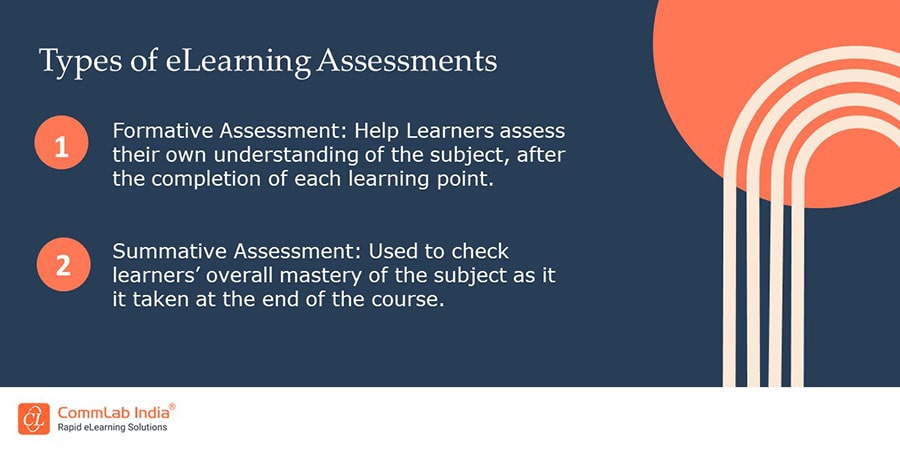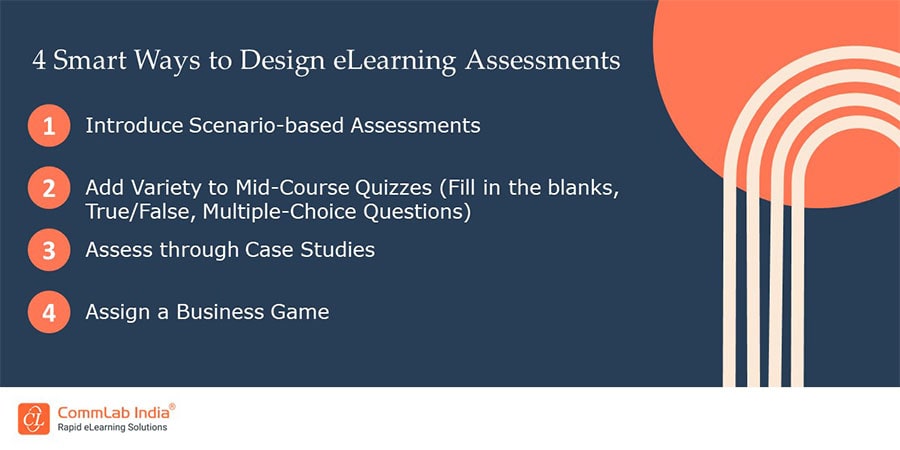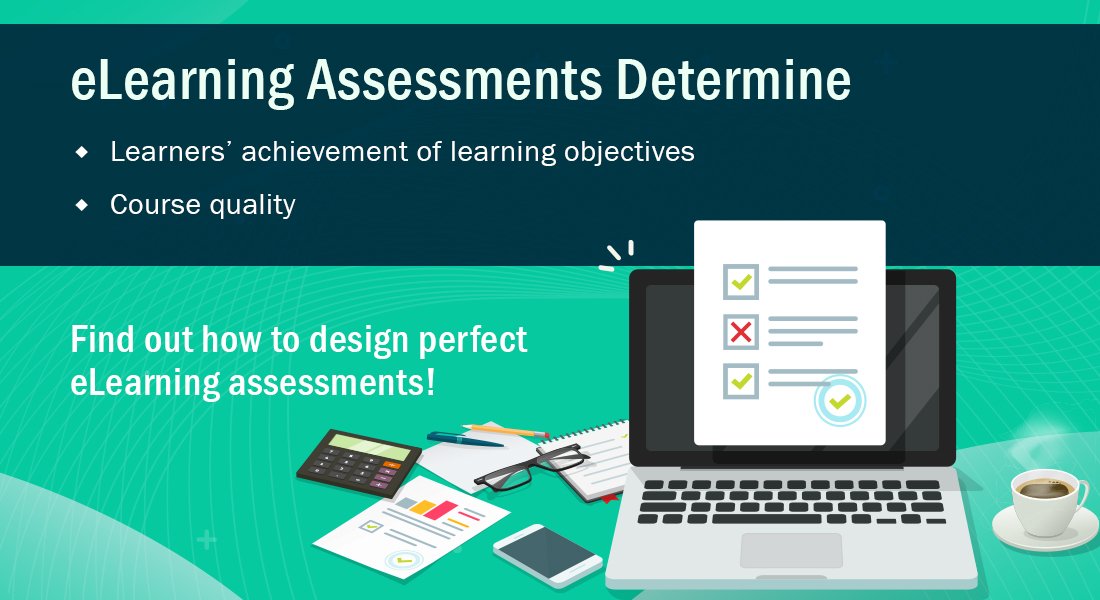Engagement Elevated — How to Design Interactive Assessments for Effective eLearning

In the realm of corporate training and development, the quest for effective eLearning strategies is ever-evolving. One crucial aspect that often determines the success of an eLearning course is the design of assessments. Assessments play a pivotal role in gauging learners' understanding, measuring progress, and reinforcing key concepts. However, traditional assessments can sometimes feel monotonous and fail to engage learners effectively. This is where interactive assessments come into play, offering a dynamic and engaging way to evaluate learners' knowledge and skills. In this blog, we will delve into the importance of assessments in eLearning, explore different types of assessments, and provide actionable tips on designing interactive assessments to elevate engagement and enhance learning outcomes.
Looking to Ace the Art of Designing Interactive eLearning Assessments?
Follow these actionable tips:
- Set clear learning objectives
- Utilize interactive formats
- Promote contextual learning
- Offer immediate feedback
- Embrace adaptive assessments
Why Assessments are Integral to eLearning Courses?
Assessments form the backbone of eLearning courses for several compelling reasons. Firstly, they serve as a litmus test to measure learners' comprehension of the course material. By assessing learners' understanding, trainers and instructional designers can identify areas of strength and weakness, allowing for targeted interventions and personalized learning paths. Additionally, assessments provide valuable feedback to both learners and trainers, highlighting areas that require improvement and reinforcing mastery of concepts. Moreover, assessments promote active learning by encouraging learners to apply their knowledge in real-world scenarios, fostering critical thinking and problem-solving skills, and empowering them to make informed decisions.
Assessments also contribute to the overall effectiveness of eLearning courses by promoting accountability and motivation. When learners know that their progress is being assessed, they are more likely to stay focused and committed to completing the course successfully. Assessments also serve as a benchmark for evaluating the ROI (Return on Investment) of eLearning initiatives, enabling organizations to assess the effectiveness of their training programs and make data-driven decisions for continuous improvement.
→ Download eBook: Become an eLearning Champion!
What are the Different Types of eLearning Assessments?
eLearning, assessments can be broadly categorized into two main types — formative assessments and summative assessments.

Formative Assessments
Formative assessments are ongoing evaluations designed to monitor learners' progress and provide feedback throughout the learning process. These assessments help learners assess their understanding of the subject, after the completion of each learning point. Examples of formative assessments include quizzes, polls, interactive exercises, and worksheets. Formative assessments are valuable for promoting active engagement, identifying misconceptions early on, and fostering a learning and growth mindset among learners.
Summative Assessments
Summative assessments, on the other hand, are conducted at the end of a learning unit or course to evaluate learners' overall understanding and mastery of the content. These assessments are often high-stakes and focus on measuring achievement against specific learning objectives or competencies. Examples of summative assessments include final tests, project assessments, simulations, and performance evaluations. Summative assessments provide a comprehensive snapshot of learners' knowledge and skills, allowing trainers to assess learning outcomes and certify competency.
Both formative and summative assessments play complementary roles in the eLearning ecosystem, with formative assessments guiding learning progress and summative assessments evaluating overall achievement and proficiency.
How to Design Interactive eLearning Assessments — 5 Actionable Tips
Now that we understand the importance of assessments in eLearning and its different types, let's explore five actionable tips for designing interactive eLearning assessments that elevate engagement and enhance learning outcomes:
Set Clear Learning Objectives
Before designing assessments, clearly define the learning objectives and desired outcomes of the eLearning course. Align assessments with these objectives to ensure they accurately measure learners' understanding and competency with the stated goals. Clear learning objectives provide a roadmap for designing relevant and meaningful assessments that contribute to learning success. The secret mantra to designing meaningful assessments is to align your questions to the organization’s learning goals and your desired learning outcomes.
Utilize Interactive Formats
Mundane multiple-choice questions in the form of “match the following” and “fill in the blanks” make assessments a boring affair. Incorporate interactive formats and multimedia elements into assessments to make them more engaging and immersive. Explore interactive question types such as drag-and-drop, scenario-based simulations, branching scenarios, and gamified assessments. Interactive assessments not only capture learners' attention but also provide opportunities for active participation and real-time feedback, enhancing the overall learning experience.
Here's a video that talks about using different assessment formats in various scenarios. Watch it now!
Promote Contextual Learning
The ultimate aim of an assessment is to gauge learners’ understanding of the delivered content to help them apply their learning in day-to-day job tasks. To ensure this, design assessments that reflect real-world scenarios and challenges relevant to learners' roles or industry contexts. Contextual learning assessments require learners to apply their knowledge and skills in practical situations, fostering deeper understanding and skill transfer. Case studies, simulations, role-playing exercises, and scenario-based assessments are effective tools for promoting contextual learning and critical thinking, thereby equipping learners to make informed decisions.

Offer Immediate Feedback
Incorporate immediate feedback mechanisms into assessments to provide learners with instant insights into their performance. Feedback should be constructive, specific, and actionable, highlighting correct answers, explaining incorrect responses, and offering guidance for improvement. Immediate feedback reinforces learning, clarifies concepts, and encourages learners to reflect on their understanding and approach.
Embrace Adaptive Assessments
Leverage adaptive assessment strategies to tailor the difficulty level and content of assessments based on learners' individual progress and proficiency. Adaptive assessments dynamically adjust question complexity, pacing, and content based on learners' responses, ensuring a personalized learning experience. Adaptive assessments promote meaningful learning, mitigate learner frustration, and optimize learning outcomes by focusing on areas that require reinforcement.
By incorporating these actionable tips into the design of interactive eLearning assessments, you can create engaging, effective, and impactful learning experiences that resonate with learners and drive continuous improvement.
Summing it Up!
Assessments play a pivotal role in the success of eLearning courses by evaluating learners' understanding, measuring progress, and reinforcing key concepts. By leveraging interactive assessment design strategies, such as setting clear learning objectives, utilizing interactive formats, promoting contextual learning, offering immediate feedback, and embracing adaptive assessments, organizations can elevate engagement and enhance learning outcomes. Interactive assessments not only capture learners' attention but also encourage active participation, hone critical thinking, and boost skill development. As organizations continue to invest in eLearning initiatives, designing interactive assessments tailored to learners' needs and preferences will be key to unlocking the full potential of online training and driving lasting impact in the corporate world.
Looking for more tips to master eLearning design and development? Download this eBook for proven insights, tips and tricks to become an eLearning champion. Get started now!



![Plan Your eLearning Assessments Like a Pro! [SlideShare]](https://blog.commlabindia.com/hubfs/Imported_Blog_Media/elearning-assessments-plan-slideshare.jpg)

